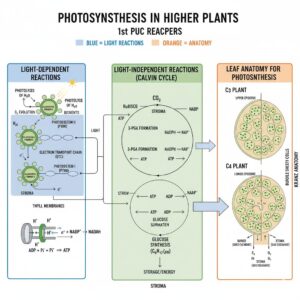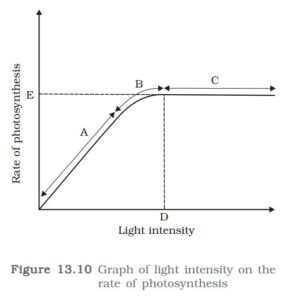1st PUC Biology Question and Answer: Photosynthesis In Higher Plants
Looking for 1st PUC Biology textbook answers? You can download Chapter 13: Photosynthesis In Higher Plants Questions and Answers PDF, Notes, and Summary here. 1st PUC Biology solutions follow the Karnataka State Board Syllabus, making it easier for students to revise and score higher in exams.
Karnataka 1st PUC Biology Textbook Answers—Reflections Chapter 13
Photosynthesis In Higher Plants Questions and Answers, Notes, and Summary
1st PUC Biology Chapter 13
PHOTOSYNTHESIS IN HIGHER PLANTS
Scroll Down to Download Photosynthesis In Higher Plants PDF
Question and Answer:
Question 1.
By looking at a plant externally can you tell whether a plant is C, or C₁? Why and how?
Answer:
C₄ plants are generally adapted to xerophytic climatic conditions and can grow well in high temperature and light intensity. However, it cannot be said conclusively whether a plant is C₃ or C₄ by merely looking at its external appearance. At most, some guess can be made by observing the fleshy leaf structure that is often found in C₄ plants.
Question 2.
By looking at which internal structure of a plant can you tell whether a plant is C₁ or C₁? Explain.
Answer:
The particularly large cells around the vascular bundles of the C₄ pathway plants are called bundle sheath cells, and the leaves which have such anatomy are said to have ‘Kranz’ anatomy.
‘Kranz’ means wreath and is a reflection of the arrangement of cells. The bundle sheath cells may form several layers around the vascular bundles. They are characterized by having a large number of chloroplasts, thick walls impervious to gaseous exchange, and no intercellular spaces.
Question 3.
Even though a very few cells in a C, plant carry out the biosynthetic – Calvin pathway, yet they are highly productive. Can you discuss why?
Answer:
In C₄ plants, the biosynthetic Calvin cycle occurs only in bundle sheath cells. Despite few cells performing the Calvin cycle, C₄ plants are highly productive due to:
- Minimum photorespiration losses.
- Adaptation to diverse climatic conditions, as they can synthesize sugars even at very low CO₂
- Ability to photosynthesize at high temperatures, unlike C₃
- Rapid withdrawal of photosynthates from the bundle sheath cells as they lie over the vascular bundles.
- Continuous photosynthesis, even when stomata are closed, because CO₂ released through respiration is efficiently fixed.
Question 4.
RuBisCO is an enzyme that acts both as a carboxylase and oxygenase. Why do you think RuBisCO carries out more carboxylation in C, plants?
Answer:
In C₄ plants, the enzyme RuBisCO is present in the bundle sheath cells, where the CO₂ concentration is very high due to the decarboxylation of organic acids (such as malic acid) formed in the mesophyll cells.
Because of this high concentration of CO₂, RuBisCO functions primarily as a carboxylase and not as an oxygenase. This minimizes photorespiration and increases the overall efficiency of photosynthesis in C₄ plants.
Question 5.
Suppose there were plants that had a high concentration of Chlorophyll b, but lacked chlorophyll a, would it carry out photosynthesis? Then why do plants have chlorophyll b and other accessory pigments?
Answer:
- No, photosynthesis would not occur in plants having a high concentration of chlorophyll b but lacking chlorophyll a, because chlorophyll a forms the reaction centre in both Photosystems I and II. It is responsible for converting light energy into electrical energy and exciting the electrons for the photolysis of water.
- Maximum photosynthesis occurs at the wavelengths absorbed by chlorophyll a molecules, i.e., in the blue and red regions of light.
- Though chlorophyll a is the major pigment responsible for trapping light, other thylakoid pigments like chlorophyll b, xanthophylls, and carotenoids (called accessory pigments) also absorb light and transfer the energy to chlorophyll a.
- These accessory pigments not only enable a wider range of wavelengths of incoming light to be utilized for photosynthesis but also protect chlorophyll from photo-oxidation.
Question 6.
Why is the colour of a leaf kept in the dark frequently yellow, or pale green? Which pigment do you think is more stable?
Answer:
We can look for an answer to these questions by trying to separate the leaf pigments of any green plant through paper chromatography. Chromatographic separation of the leaf pigments shows that the colour we see in leaves is not due to a single pigment but due to four different pigments:
- Chlorophyll a – bright or blue-green in the chromatogram
- Chlorophyll b – yellow-green
- Xanthophylls – yellow
- Carotenoids – yellow to yellow-orange
Chlorophyll a is the chief pigment associated with photosynthesis. When a leaf is kept in the dark, chlorophyll degrades and the yellow pigments (xanthophylls and carotenoids) become visible, indicating that carotenoids are more stable than chlorophyll.
Question 7.
Look at leaves of the same plant on the shady side and compare it with the leaves on the sunny side. Or, compare the potted plants kept in the sunlight with those in the shade. Which of them has leaves that are darker green? Why?
Answer:
Leaves on the shady side of a plant, or plants kept in the shade, are darker green compared to leaves exposed to sunlight.
Reason:
- In low-light conditions, plants produce more chlorophyll (both chlorophyll a and b) to capture maximum light for photosynthesis.
- In bright sunlight, less chlorophyll is sufficient for photosynthesis, so sun-exposed leaves are lighter green.
Additional Note:
- Shade leaves are also generally broader and thinner to absorb more light.
- Sun leaves are smaller and thicker to prevent water loss and protect chlorophyll from intense light.
Question 8.
Figure 13.10 shows the effect of light on the rate of photosynthesis. Based on the graph, answer the following questions:
(a) At which point/s (A, B or C) in the curve is light a limiting factor?
(b) What could be the limiting factor/s in region A?
(c) What do C and D represent on the curve?
(a) At which point/s (A, B or C) in the curve is light a limiting factor?
Answer:
Light is a limiting factor at region A, where the rate of photosynthesis increases linearly with an increase in light intensity.
(b) What could be the limiting factor/s in region B?
Answer:
In region B, the rate of photosynthesis starts to plateau, so light is no longer limiting.
The limiting factors could be:
- CO₂ concentration
- Temperature
- Enzyme activity
(c) What do C and D represent on the curve?
Answer:
- C represents the saturation point, where the rate of photosynthesis reaches its maximum (Pmax).
- D represents the light-saturated region, where increasing light further does not increase photosynthesis, because other factors have become limiting.
Question 9.
Give comparison between the following:
(a) C₁ and C, pathways
(b) Cyclic and non-cyclic photophosphorylation
(c) Anatomy of leaf in C, and C, plants
Answer:
(1) Difference between C3 and C4 pathways:
C3 pathway or Calvin cycle:
- The primary acceptor of CO₂ is RuBP, a 5-carbon compound.
- The first stable product is 3-PGA, a 3-carbon compound.
- It operates under low CO₂ concentration in mesophyll cells.
- CO₂ once fixed is not released back.
- Net gain of one molecule of glucose requires consumption of 6 CO₂
- Fixation of one molecule of CO₂ needs 3 ATP and 2 NADPH₂ molecules; thus, 18 ATP are required for synthesis of one glucose molecule.
- C3 cycle operates in all categories of plants.
- Rate of CO₂ fixation is slow.
- Optimum temperature for operation is 10–25°C.
C4 pathway or Hatch & Slack cycle:
- The primary acceptor of CO₂ is PEP, a 3-carbon compound.
- The first stable product is oxaloacetic acid, a 4-carbon compound.
- It can operate under very low CO₂ concentration in mesophyll cells.
- CO₂ once fixed is released back in bundle sheath cells, where it is finally fixed and reduced by the Calvin cycle.
- There is no net gain; it involves additional consumption of 12 ATP molecules per glucose molecule.
- Fixation of one molecule of CO₂ needs 2 ATP molecules in addition to that required in C3 cycle; 30 ATP are required for one glucose molecule.
- C4 cycle operates only in C4 plants.
- Rate of CO₂ fixation is faster.
- Optimum temperature for operation is 30–45°C.
(2) Differences between Cyclic and Non-cyclic Photophosphorylation:
Cyclic photophosphorylation:
- Performed by photosystem I independently in stroma or thylakoids.
- External electron source not required as electrons are recycled.
- Not connected with photolysis of water; no oxygen is evolved.
- Electrons expelled by the photo center P700 return to it after passing through electron carriers.
- Activated by light of 700 nm wavelength.
- Generates ATP only; no NADPH is formed.
- Chlorophyll does not receive electrons from water.
- Operates under low light, anaerobic conditions, or when CO₂ is limited.
- Does not directly take part in photosynthesis except in some bacteria.
Non-cyclic photophosphorylation:
- Carried out by both PSI & PSII in grana thylakoids.
- Requires an external electron donor.
- Connected with photolysis of water; oxygen is evolved.
- Electrons expelled by P680 are not returned but reach NADP⁺.
- Photo centers absorb light of 680 nm and 700 nm.
- Produces both ATP and NADPH₂.
- Ultimate electron source is water; NADP⁺ is the final acceptor.
- Operates under optimum light, aerobic conditions, and presence of CO₂.
- Dominant in green plants and directly linked with CO₂
(3) Differences between anatomy of leaf in C3 and C4 plants:
C3 leaf anatomy:
- Rate of photosynthesis is influenced by leaf anatomy, which affects sunlight availability, CO₂ diffusion into mesophyll cells, and translocation of end products.
- Important features: cuticle thickness, stomata number and distribution, stomatal opening, size and number of chloroplasts, intercellular spaces, vascular strand distribution.
C4 leaf anatomy (Kranz anatomy):
- In some tropical grasses, bundle sheath cells around vascular strands are large, green, and barrel-shaped.
- Surrounded by one or more concentric layers of mesophyll cells.
- Mesophyll and bundle sheath cells are connected by plasmodesmata.
- Chloroplasts in bundle sheath cells are large but have less well-defined grana.
Additional Questions & Answers
Question 1.
What is the difference between photophosphorylation and oxidative phosphorylation?
Answer:
- Photophosphorylation: ATP synthesis using light energy during photosynthesis; occurs in chloroplasts; involves PSI and PSII.
- Oxidative phosphorylation: ATP synthesis using energy released from oxidation of food molecules; occurs in mitochondria; involves electron transport chain and chemiosmosis.
Question 2.
What is the role of stomata in photosynthesis?
Answer:
- Stomata regulate the exchange of gases; they allow CO₂ to enter for photosynthesis and release O₂.
- They also help in transpiration, which maintains water movement and nutrient uptake.
Question 3.
What are accessory pigments? Name them and explain their function.
Answer:
- Accessory pigments are pigments other than chlorophyll a that absorb light and transfer energy to chlorophyll a.
- Examples: Chlorophyll b, carotenoids, xanthophylls.
- Function: They increase the range of wavelengths absorbed for photosynthesis and protect chlorophyll from photo-oxidation.
Question 4.
What is photolysis of water? Where does it occur?
Answer:
- Photolysis of water is the splitting of water molecules into H⁺, OH⁻, and O₂ using light energy.
- It occurs in the thylakoid lumen during the light reaction in photosystem II.
Question 5.
Why do C4 plants have higher photosynthetic efficiency at high temperatures?
Answer:
- C4 plants have bundle sheath cells and PEP carboxylase which minimizes photorespiration.
- They can fix CO₂ efficiently even when stomata are partially closed, reducing water loss.
- Calvin cycle occurs in bundle sheath cells, enabling high photosynthetic rate at 30–45°C.
Question 6.
What is the significance of cyclic photophosphorylation?
Answer:
- Provides ATP without NADPH formation.
- Helps maintain ATP/NADPH balance for the Calvin cycle.
- Useful under low light intensity or when CO₂ is limited.
Question 7.
Define light compensation point and light saturation point.
Answer:
- Light compensation point: Light intensity at which rate of photosynthesis equals rate of respiration; net CO₂ exchange is zero.
- Light saturation point: Light intensity beyond which increase in light does not increase the rate of photosynthesis.
Question 8.
Why do C3 plants show photorespiration while C4 plants do not?
Answer:
- C3 plants: RuBisCO enzyme fixes O₂ instead of CO₂ under high temperature and low CO₂ → photorespiration occurs.
- C4 plants: CO₂ is concentrated in bundle sheath cells, reducing O₂ fixation by RuBisCO → minimal photorespiration.
Question 9.
What are the end products of light and dark reactions of photosynthesis?
Answer:
- Light reaction: ATP, NADPH₂, O₂ (from photolysis of water)
- Dark reaction (Calvin cycle): Glucose or carbohydrates, ADP, NADP⁺
Question 10.
Explain why chlorophyll appears green.
Answer:
- Chlorophyll absorbs light mainly in red and blue regions.
- It reflects and transmits green light, which is why leaves appear green.
Question 11.
What is the role of bundle sheath cells in C4 plants?
Answer:
- They contain chloroplasts where the Calvin cycle occurs.
- CO₂ is concentrated in bundle sheath cells to minimize photorespiration.
- They are tightly packed with fewer intercellular spaces to prevent CO₂


